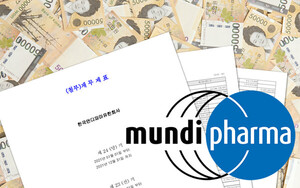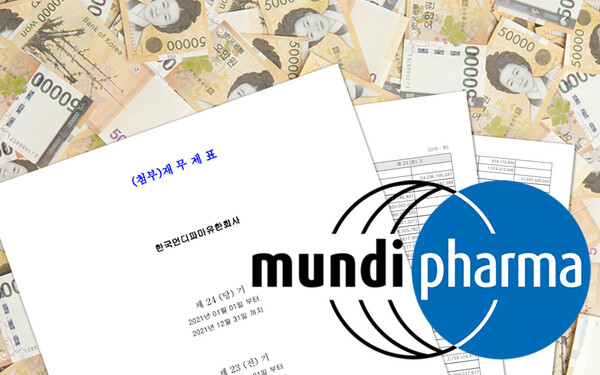
There is a multinational pharmaceutical company established in 1998 and has been operating in Korea for more than 25 years. The company has been known as a so-called “meaty” firm, strengthening its solid status in cancer pain treatment. However, a look into the recent audit report showed it had accumulated debt of about 200 billion won ($156 million).

Has the company been doing a “holistic” business in Korea, enduring losses for more than 25 years? Was there a major financial crisis for the company over the 25 years?
Some might have noticed what company it is from the “cancer pain treatment” part — the company mentioned above is Mundipharma Korea.
Mondipharma Korea began its operation in 1998, conducting various businesses focusing on pain killers, including narcotic analgesics, and spreading to pulmonary disease treatments. Considering Korea’s health and medical environment marked by population aging and an increase in cancer patients, one cannot help but think the company has grown steadily, like other pharmaceutical companies.
Why does only Mundipharma have 200 billion worth of debt, then?
Mundipharma Korea management’s “real self” has been disclosed since the company was included in companies subject to a “new external audit law” that went into effect in 2020. The new law obligates corporations and limited liability companies with assets or sales of 50 billion won or more in the previous business year to undergo external audits and disclose audit reports. Accordingly, Mundipharma Korea, a limited company, made public its audit reports in 2020 and 2021.
Looking at these audit reports, one can seldom suppress questions. Although the company generated operating profit in the year the audit was conducted, it has since continued to do business, risking losses due to unknown debt. The losses have piled up to snowball to debt in hundreds of billions of won.
According to Mundipharma Korea’s 2022 audit reports, the company’s assets totaled 54.8 billion won in 2021, but its total debt amounted to 197 billion won. Notably, current liabilities that must be repaid within a year reached 137.3 trillion won. It was over 50 billion won, larger than the company’s total revenue of 84.7 trillion won, and 98 times higher than its paid-in capital of 1.4 billion won. As a result, Mundipharma Korea’s total capital in 2021 was minus 142.2 billion won.
These figures set themselves apart from those of other multinational pharma firms. For instance, the 2021 revenue of Sanofi Pasteur and Kyowa Kirin Korea was 87.5 billion won and 79.5 billion won, similar to Mundipharma Korea’s 84.7 billion won.
However, Sanofi Pasteur’s total capital was 22.7 billion won, with assets of 53.8 billion won against debts of 31.1 billion won. Kyowa Kirin Korea’s total capital was 40.3 billion won, as its assets were 65.6 billion and its debts were 25.3 billion. The two companies had debts but did not exceed total assets to record pluses in total capital.
Is Korea a bottomless jar for Mundipharma?
Most of Mundipharma Korea’s debt was borrowed money. In 2021, it borrowed 77.5 billion won from Mundipharma Holdings AG, 78.6 billion won from Pharmaceutical Research Associates (PRA), and 9.2 billion won each from Rosebay Medical and Hambert BV, each of which holds a 50 percent stake in Mundipharma Korea. These alone amounts to 174.6 billion won. The company must pay 123.6 billion within a year, with the other 51 billion being long-term loans that can exceed five years. Mundipharma Korea had to pay 3.8 billion won, about half of its operating profit, in interest in 2021.
A closer look into the sales structure showed that the cost was 44.3 billion won, with a cost ratio of 52 percent among sales of 84.7 billion won (with the other 40.4 billion won in total profit). Therefore, excluding sales costs and management expenses of 32.6 billion, 7.7 billion won was left as operating profit.
However, its net profit was minus 11.5 billion won. The company earned 6.6 billion won in non-operating income but suffered a loss of 25.8 billion in non-operating costs. Most of this loss was foreign exchange loss amounting to 20.5 billion won. Mundipharma Korea, with heavy foreign currency debt, had to suffer an exchange loss of more than 20 billion won.
As a result, Mundipharm Korea’s total net profit in 2021 was minus 11.5 billion won, paying zero won in corporate tax. Besides, the transferred loss swelled to 58.3 billion won in 2021. That makes one suspect Mundipharma Korea had accumulated losses until the disclosure of audit reports. In other words, Mundipharma International put capital in its money-losing Korean offshoot every year, and its debt accumulated to reach 200 billion won.
What could be the background of the 200 billion won debt?
Pharmaceutical companies continued to grow during the Asian financial crisis of 1997-98 and even the Covid-19 pandemic. Even during recessions, people must go to hospitals if they get sick, and patients must take drugs. Therefore, drugmakers can suffer losses for a year or two due to negative issues. Still, it is hard to understand to accumulate 200 billion in debt while conducting pharmaceutical business for over 20 years.
Accountants also expressed doubts about Mundipharma Korea’s audit reports.
“Given the market share of products the company has and its track records, I can hardly understand how its financial sheets take a form like this,” said an expert at a local accounting firm. “We can guess many things by cost-sales ratio, but Mundipharma’s cost ratio is good with 50-60 percent.”
The heavy debt may be because it borrowed money from its headquarter office in the initial stage. Or, it might have bought products from its headquarters at high prices and could have left a margin at the latter. However, the accountant added all these speculations before looking into previous financial sheets.
“If the company had no operating base when it established the Korean offshoot, a large amount of borrowing could be expected due to high initial investment cost. However, this company must have generated revenue in the first year, given the industry’s structure, and could not suffer heavy loss in operating profits,” another accountant said. “I am curious what their previous balance sheets look like.”
The accountant noted that the transfer loss of 58.3 billion won could not have grown to this level in a couple of years, adding it became possible because previous tax bases were all in the red.
“Moreover, foreign exchange gains and losses do not affect transfer losses, and so, most of the loss is related to operating loss,” the accountant said. “That means the company suffered the loss of more than 50 billion won in taxation terms over the past 20 years.”
Late last month, Korea Biomedical Review asked about the background of debt by making calls and sending emails to Mundipharma Korea and Mundipharma International. Unfortunately, the former avoided answers, and the latter sent its reply via email.
“Mundipharma Korea’s audit reports were made according to the business and accounting rules of the Republic of Korea,” the headquarters office said. “We cannot provide additional opinions or information concerning the audit because they are trade secrets.”
Meanwhile, U.S.-based Perdue Pharma has recently filed for bankruptcy due to its responsibility for the excessive use of the opioid product, reducing the workforce in the painkiller business unit in Korea, too. Sixty of 90 employees were curtailed, and discussions are reportedly underway to retain the workforce between the management and union.
Source link
